I decided to celebrate July 4th by brushing up on my grasp of 20th-century military history, delving into Stephen E. Ambrose’s 1994 bestseller, D-Day: June 6, 1944, The Climactic Battle of World War II (New York: Touchstone Books). Ambrose devotes four pages to the still photographers and film crews who went to Omaha Beach that day. He pays particular attention to Robert Capa and Hollywood director/producer John Ford.
Though described by reviewers as “definitive” and “the best book yet on what many historians consider to be the most important day of the 20th century,” Ambrose’s extensively researched study manages to get wrong almost everything about Robert Capa’s time on Omaha Beach, and the subsequent fate of his negatives. To wit:
- “Perhaps the bravest [photographer] and certainly the best known that day was Robert Capa of Life magazine, who went into Omaha with Company E in the second wave. His craft mislanded at Easy Red. Capa was last off. He paused on the ramp to take a photograph.” Actually, he paused on the ramp to make 5 photographs (negatives 29-33 — click contact sheet to enlarge), keeping the Higgins boat on which he’d arrived within range of enemy guns unnecessarily for almost two minutes, which is why the coxswain booted him off.
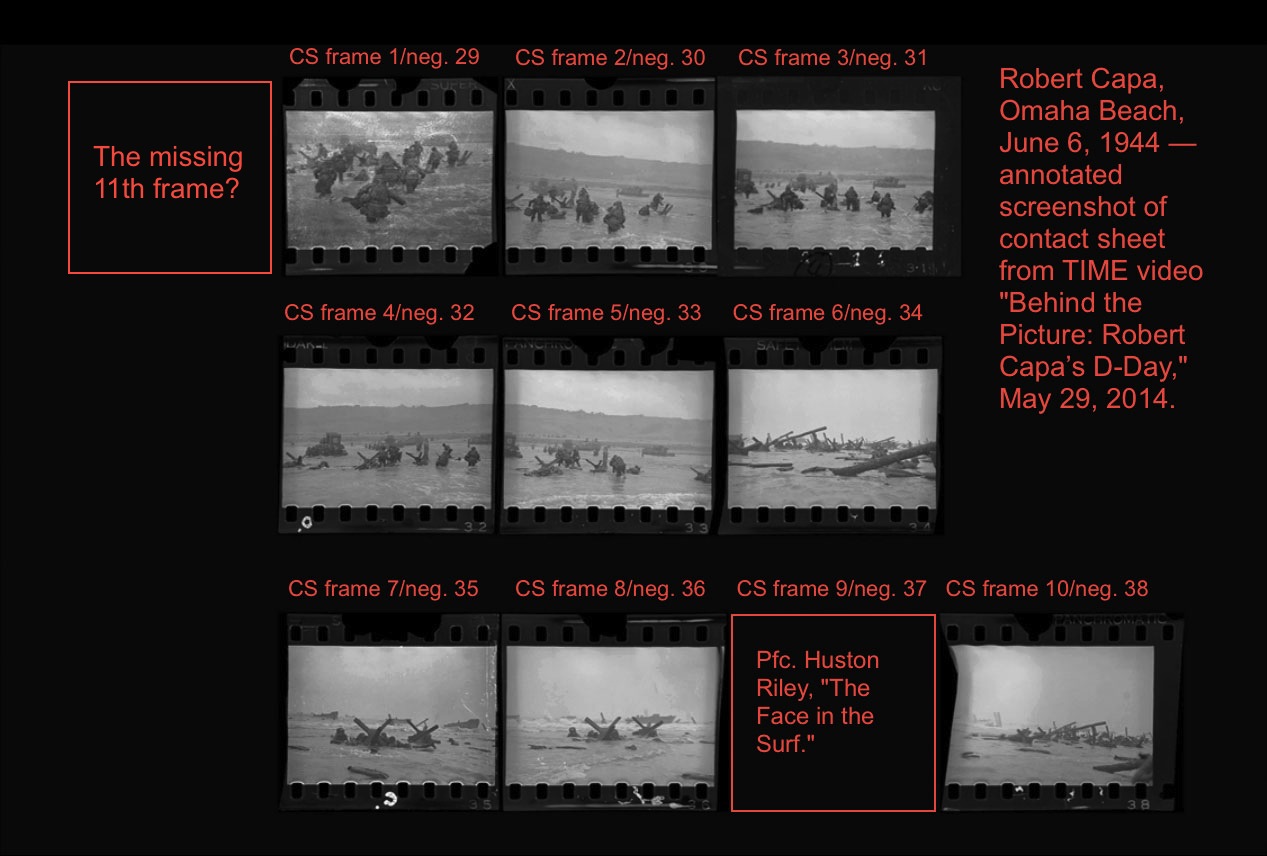
Robert Capa, D-Day images from Omaha Beach, contact sheet, screenshot from TIME video (May 29, 2014), annotated.
- “Capa got behind an obstacle and shot a roll of film.” In fact, he made only one exposure from behind that obstacle (negative 34).
- “Capa finally made it to the seawall, where he threw himself to the ground.” The evidence in his images suggests that he never got to dry ground and the seawall (sometimes referred to as the “shingle”), but only as far as the shelter of the burned-out Armored Vehicle 10 (seen at left in his negatives 31-33), where a number of troops clustered.
- “Capa kept shooting, inserting new rolls of film and shooting some more.” Capa exposed no more than 11 frames on one roll of film at Omaha Beach. (The reported 11th frame has vanished.) By his own account, he never reloaded either of his Contax cameras while he had his boots on the ground there. The three frames he made from behind Armored Vehicle 10 (negatives 35-37), including the one of Pfc. Huston Riley that graces the cover of Ambrose’s book, plus a final one made en route to the LCI for evacuation (negative 38), were his last exposures from the landing.
- “He ran low on film. Turning to the beach, he saw an LCI.” Having expended less than one-third of a 36-exposure roll of 35mm film on Omaha Beach up to that point, Capa could not possibly have “run low on film.” He himself states in his memoir that he reloaded both his Contax II cameras upon reaching LCI(L)-94.
- “Capa got back to Portsmouth that day, then went by train to the developing studios in London. He turned in his film for development.” According to the U.S. Coast Guard records, after picking up wounded soldiers the U.S.S. Samuel Chase returned not to Portsmouth but to Weymouth, from which it had departed on June 5, arriving on the morning of June 7. Rather than accept the offer of a plane ride to London, so as to put his eagerly awaited images directly into John Morris’s hands at LIFE‘s London office in plenty of time to meet the urgent deadline (and also make them available to the Associated Press pool), Capa turned his films over to a courier, changed his clothes, and caught the next ship back to Normandy, where the battle had long since ended.
- “The darkroom assistant was so eager to see the photographs that he turned on too much heat while drying the negatives. The emulsions melted and ran down.” This relies entirely on a single eyewitness account, that of John Morris. It remains otherwise unproven, and numerous expert sources question its credibility.
- “Of the 106 pictures Capa had taken, only eight were salvaged and they were blurry.” Per the above, Capa took 11 pictures of the landing on Omaha Beach, at most. According to John Morris, all 11 were “salvaged,” the blurred frames among them no blurrier than one might expect from a cold, wet, frightened photographer standing in the ocean while using a comparatively slow film shortly after dawn on a gray, overcast day.
All the above comes compressed on pp. 394-95 of Ambrose’s tome. Sobering, to say the least. It’s enough to make you wonder who you can trust; if I can invalidate this much of Ambrose’s research on a subject about which I’m informed, what errors and falsehoods does his book contain that I don’t know enough to question?
(I also have to challenge the use of the word “climactic” in Ambrose’s title. Stalingrad had already proved far costlier to the Nazis, the beginning of the end. The Germans never regained the initiative on the eastern front, and their withdrawal of battle-hardened troops from the western front to compensate for their devastating losses at Stalingrad proved an important factor in the Allies’ success on D-Day.)
The Devil’s in the Details
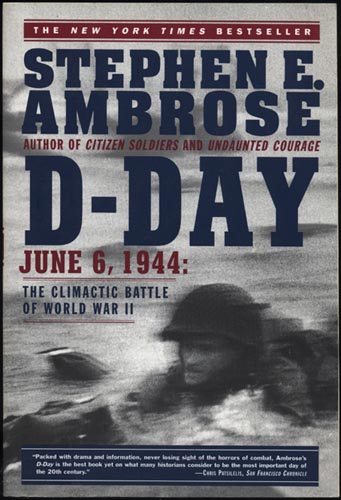 Yet, amidst all this uncritical parroting of the party line and transmission of simply erroneous notions (train to London? eight remaining negatives?), Ambrose offers up two little verifiable nuggets of reliable fact that enable us to establish the actual timeline of Capa’s arrival at and departure from Omaha Beach.
Yet, amidst all this uncritical parroting of the party line and transmission of simply erroneous notions (train to London? eight remaining negatives?), Ambrose offers up two little verifiable nuggets of reliable fact that enable us to establish the actual timeline of Capa’s arrival at and departure from Omaha Beach.
Ambrose takes great pains in his book to get the timing of the assault straight. So when he says that Capa “went into Omaha [Beach] with Company E in the second wave,” we can consider that dependable. The National WWII Museum confirms this: “Capa accompanied men from Company E of the 16th Infantry Regiment, U.S. 1st Division in the second assault wave. He landed at the Easy Red sector.” This of course impeaches the oft-repeated fiction that he went in with the first wave, which started landing at 06:35 (Ambrose gives the arrival of the first wave as 07:00), or with whatever Capa Archive Curator Cynthia Young means by what she calls “the second half of the first wave.”
Capa elected to go in with E Company (nicknamed Easy Company) of the 16th Regiment, 2nd Battalion, 1st Infantry, for several reasons. He’d accompanied them during the Sicilian campaign of the previous year, so he had many friends and acquaintances there. Just as importantly, these were men with serious combat experience, whereas the vast majority of the U.S. troops on D-Day were headed to their very first battle. Capa understandably felt safer among veterans than amidst raw recruits.
The Intelligence and Reconnaissance Platoon of the 16th Infantry Regiment, 1st Infantry Division landed first on Omaha Beach with the second assault wave. “At 07:10 … the first I & R landing craft struck bottom approximately two hundred yards off shore.” (See “Item # 9, I & R Platoon Diary 6 June 1944,” at the First Division Museum website.) Thus, given that Capa’s first images show second-wave troops well ahead of him, and some first-wave troops already on the beach, we can pinpoint the landing of Capa’s LCVP at 07:20 at the earliest, 07:40 at the latest.
The other jewel lurking in Ambrose’s heap of junk comes from an oral-history interview conducted with Coast Guardsman Charles Jarreau, a 17-year old (!) serving on LCI(L)-94, from the archives of the Eisenhower Center at the University of New Orleans. Jarreau recalls spotting Capa coming toward them after they unloaded their troops:
“‘Poor fellow, he was there in the water, holding his cameras up to try to keep them dry, trying to catch his breath.’ Capa called out for help; the skipper told him to come aboard. ‘He was really grateful to get out. He came aboard. He took pictures on our ship, which appeared in LIFE magazine.'” [Click here for the image that appeared in LIFE.]
This gives us one eyewitness to Capa’s departure from the beach, but no timeline. (Alex Kershaw uses Jarreau’s account to confirm Capa’s boarding of LCI(L)-94 in his 2004 book Blood and Champagne: The Life and Times of Robert Capa.) Fortuitously, nosing around online, I discovered a corroborating account, “D-Day through the eyes of a Coast Guardsman,” posted at Coast Guard Compass, “The Official Blog of the U.S. Coast Guard,” by Lt. Stephanie Young on June 6, 2012. This post consists mainly of excerpts from the diary of Motor Machinist’s Mate 1st Class Clifford W. Lewis, a crewman aboard the same Coast Guard-manned LCI(L)-94 on which Jarreau served. In the section of his journal devoted to D-Day, Lewis wrote,
“We crunched on the beach at 0747 amid loud explosions which made the ship shudder. We disembarked our troops and started out when the Skipper noticed we had fouled an LCVP with a line and started back in to assist them. At that moment 3 shells burst into the pilot house and exploded killing 3 of my shipmates and wounding two including an officer.
“Couldn’t do any more for the LCVP so we cut the line and started off the beach again after the pilot house was cleared and hand steering put into operation. We had been on the beach 50 minutes and were now high-tailing it out minus the port ramp which had to be cut away. A LIFE photographer came aboard our ship from the beach and was soaking wet. He came into the Engine room to get dry. I was relieved and went top side to cool off and assist.”
In his own account of boarding the LCI which took him away from Omaha Beach in his 1947 memoir, Slightly Out of Focus, Capa describes an explosion that took place moments after he came aboard, killing several crew members:
“I reached the boat. The last medics were just getting out. I climbed aboard. I felt a slight shock and I was all covered with feathers. ‘What is this? Is somebody killing chickens?’ Then I saw that the superstructure [pilot house] had been shot away and the feathers were the stuffing from the kapok jackets of the men who were blown up. The skipper was crying because his assistant had been blown all over him and he was a mess.”
Based on Lewis’s diary entry, that happened just minutes after they disembarked their troops — somewhere around 07:50. (Lewis’s account is reconfirmed here by other sources.) If these details add up, then, Capa reached Omaha Beach at 07:20 at the very earliest, and clambered into the relative safety of the LCI at 07:50, just 30 minutes later. (Coincidentally, according to Ambrose, LCI(L)-94’s skipper, nicknamed Popeye, kept an ample supply of liquor on hand, which the hard-drinking Capa would certainly have appreciated.)
That boat departed Omaha Beach at at 08:37, meaning that Capa sat aboard LCI(L)-94 — still on the edge of the beach — for an additional 47 minutes. So Capa was at Omaha Beach for a maximum of 72 minutes, following the second-wave troops and photographing them for only half an hour.
LCI(L)-94 offloaded its wounded and dead (and Capa) to another vessel, but did not return to the Chase, instead remaining in service. Presently I can’t specify the time for that transfer, so the moment of Capa’s re-boarding the Chase isn’t known.
•
(Note: There’s an alternative version of Capa’s departure, based on an oral-history video interview with Pfc. Huston Riley, made by Larry Cappetto on Omaha Beach on June 7, 2004, available for purchase through his website, Veterans History Project. You can download the text of this interview here, and download an audio version here.
In this and other accounts of his rescue by “a buck sergeant from E Company and … a photographer with a camera around his neck and a press insignia on his shoulder,” Riley says, “All I could think of was, ‘What in the hell is this guy doing here?’ Then he ran off into the water to a landing craft.” Riley thus corroborates what Capa’s 11 negatives suggest — that, immediately after making the iconic image of Riley and helping to pull him to safety, Capa raced to an LCI in order to get away from the horrific battle.
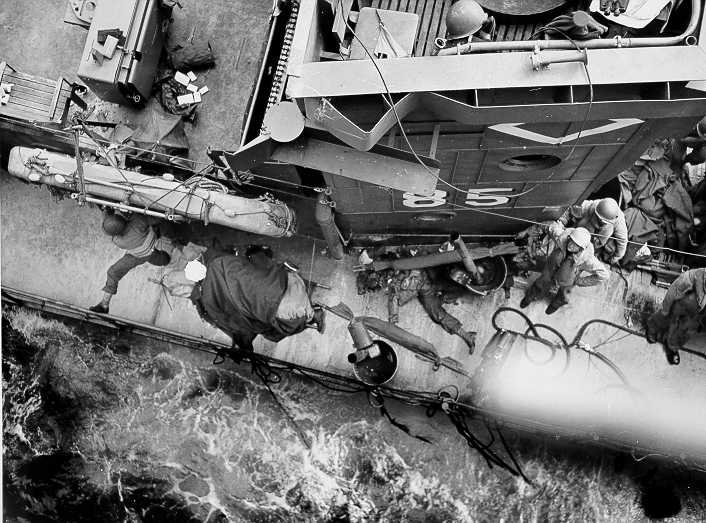
The mortally damaged USS LCI(L)-85, her decks littered with the dead, lays alongside the attack transport USS Samuel Chase (APA-26). Her crew managed to disembark the survivors before sinking. Note how the censor scratched off the dead soldier’s face.
USCG photo, 6 June 1944.
The version of this undated story that appears under the title “The Face in the Surf” by Lowell L. Getz identifies the LCI toward which Capa raced as LCI(L)-85. (Note: This is Getz’s assertion, not Riley’s.) However, according to the Coast Guard records,
“The LCI(L)-85 struck a mine and was hit by at least 25 artillery shells. Its commanding officer stated, ‘The 88’s began hitting the ship, they tore into the compartments and exploded on the exposed deck. Machine guns opened up. Men were hit and men were mutilated. There was no such thing as a minor wound.’ It returned to the Chase and off loaded the wounded before she sank.”
According to that source, LCI(L)-85 was “mortally damaged” and sank shortly after limping back to the Chase and offloading its wounded and crew. (Lewis, aboard LCI(L)-94, witnessed this: “The [LCI(L)] 85 was near a transport with troops still aboard and was listing badly. She finally got her troops off before she sunk.”) Thus, clearly, this isn’t the LCI Capa took back to the Chase. Absent more persuasive evidence otherwise, the independent eyewitness accounts of Capa coming aboard LCI(L)-94 by two uninjured crew members from that vessel stand as the most plausible version of the narrative of his departure from Omaha Beach.
•
(For an index of links to all posts in this series, click here.)



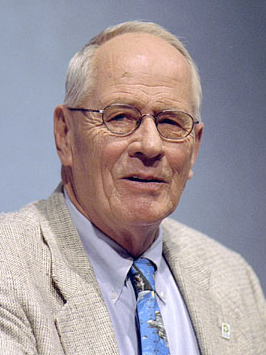
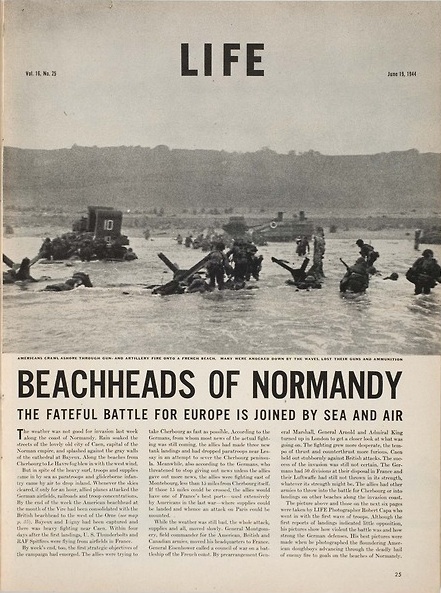
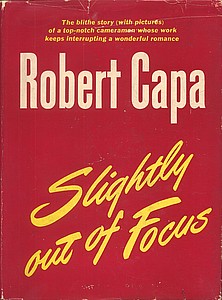




What a series on Capa and WWII! Indeed, who could blame him for getting the hell outta there when he could.
Easy Company was probably called that because the military phonetic alphabet in use at the time used “easy” for the letter E, rather than the current “echo”:
http://usmilitary.about.com/od/theorderlyroom/a/alphabet.htm
I had a friend who was a Klavierbaumeister, German-government-certified and -licensed master piano builder, the scion of an old German piano-building family (Gertz; his grandfather and great-uncle designed modern Mason & Hamlins, the finest piano ever built in the U.S.) who saw all this from the other side, as a child. He was drafted into the U-boat service in 1942 at 14, captured, escaped, put back into service, wounded and captured again, released at the end of hostilities to walk home to Hannover, a journey of several months – at the ripe old age of 17. He was a very serious man, not humorless, but he didn’t suffer fools (of whom there are quite a few in the professional classical-music world, esp. in the dept. of piano-playing) at all.
How did anyone survive? Tony Judt’s “Postwar” talks about that, and about how it nearly didn’t happen. I’m reading it slowly, in small chunks, with large breathing spaces in between.
-Nick
“Easy” was indeed the call sign for E Companies throughout the U.S. military. It certainly didn’t mean they had an easy time of it anywhere.
On a strictly human level, I admire Capa for volunteering to go in the first place, and don’t blame him for getting out. But a professional — soldier, medic, journalist — doesn’t get to act on the basis of purely personal responses in such a situation and still retain professional credibility. Hence, I think, the seven decades of obfuscation around what actually happened there — how long he stayed, how many exposures he made, etc.
The more I read about D-Day, look at photos, watch documentary films on the battle (none of which I’ve ever done in such depth before), the more astonishing it seems to me that anyone on either side survived — much less that, after 5 hours the battle was effectively over and the Allies had won. It was hell on earth.
Allan,
I have to admit that a few issues ago I was thinking “enough with the Capa, you made your point.” Now I am seeing that your persistence has taken this thing to another level. The additional research does clear up the history while at the same time gets us thinking about how difficult getting facts from even the fairly recent past can be. It also raises one of the fundamental issues of photography (and history) – the difference between the appearance of truth and the truth. I like Stephen Colbert’s word “truthiness.”
Won me over on this one.
Best,
Chuck
Exactly. The goal here isn’t trashing Capa’s memory, trivializing what he did achieve in his life, or badgering an almost-centenarian (John Morris). It concerns the ways in which myth/legend can come to surround an individual and/or an event to such an extent that it obscures what actually happened — especially when those with vested interests feed the fiction.
It also concerns the close reading of photographs. For all the verbiage about the “magnificent eleven” over the past 70 years, no one has actually analyzed them, frame by frame, vis-a-vis what they reveal regarding Capa’s time on Omaha Beach. His biographers, and his archivists, and his former picture editor, have spent their time instead polishing the myth. Alas.